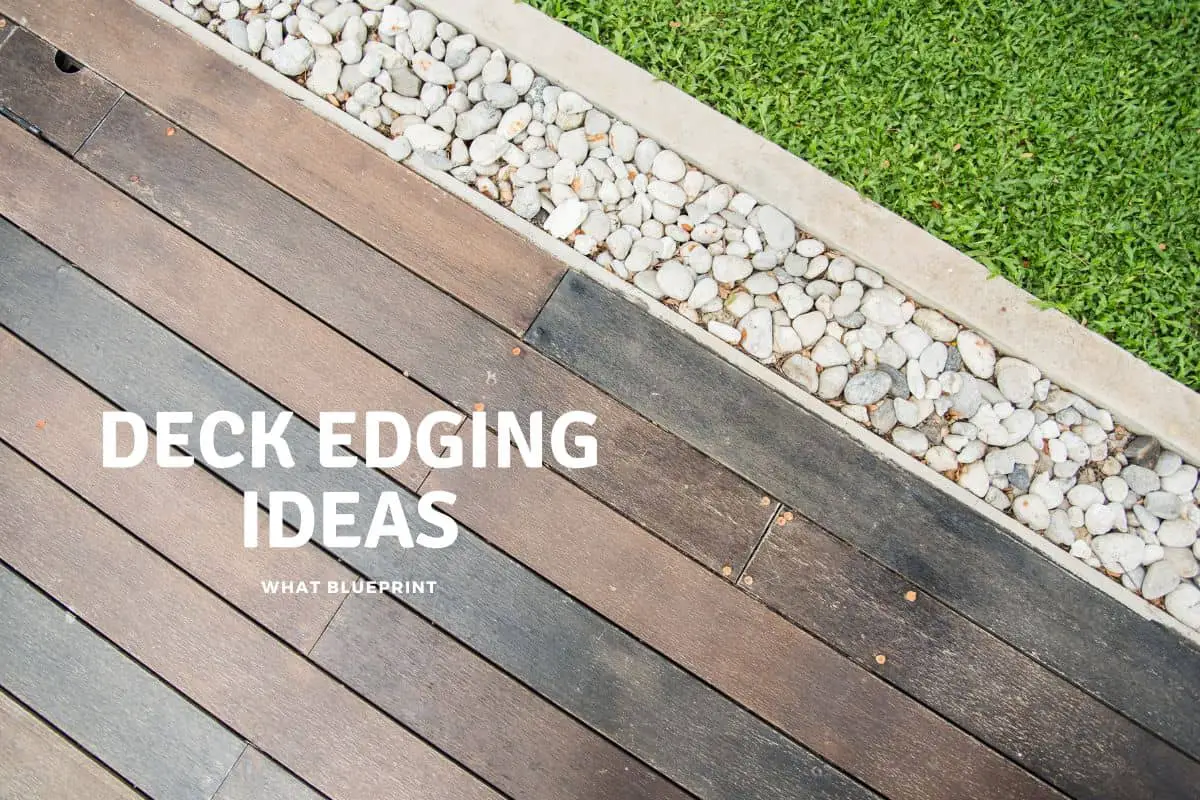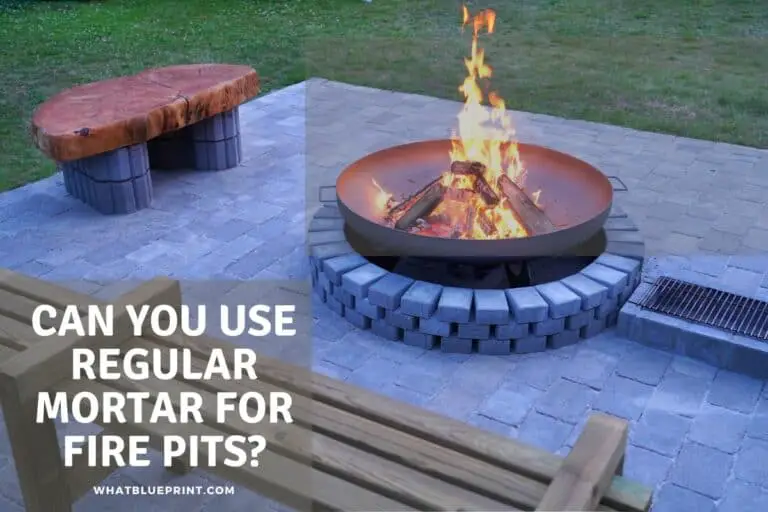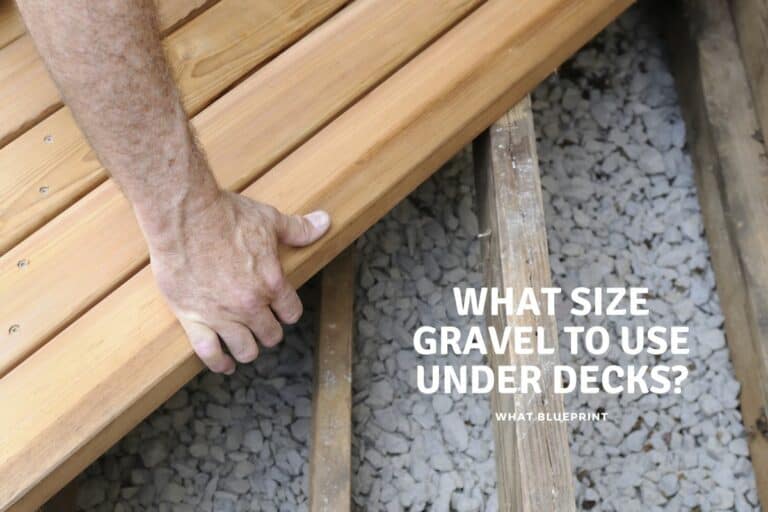Deck Edging Ideas
When designing your deck, it’s easy to ignore the fact that the edging you choose is as important as the choice of decking material and the style of the deck. Edging will give the deck that finished look, and the edging you select can define its whole character.
Deck edging ideas will be influenced by whether the deck is built at ground level or whether it’s been raised. Raised decks, in turn, will require different choices of edging, and these will also vary, as will the skirting, depending on the height of the deck above ground.
We highlight some of the best ideas for making your deck look beautifully finished off and unique.
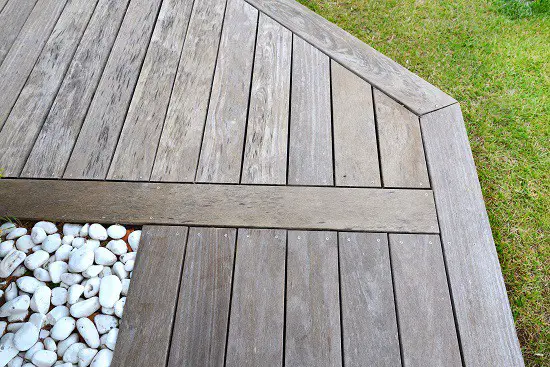
Painting Decking Board Ends Is A Simple Edging Idea
Unlike wood, composite decking may have a beautiful exterior color, but the ends will show the raw material used in its manufacture. The simplest way to match the ends to the main decking boards is to paint them with color-matched paint.
The advantage of this deck edging method is that it’s the cheapest solution and the quickest to apply. With a wooden deck, the beams are solid, and there is no problem matching the ends to the rest of the board by staining, varnishing, or painting.
The most significant disadvantage is that composite boards are not solid, often manufactured with a scalloped void in the center to reduce weight, and painting will not hide it. Despite the matching color, painting the ends will still leave the deck looking unfinished.
Using Plastic End Caps As Edging For Composite Decking
Plastic or vinyl caps, color-matched to the main decking boards, provide a neat deck edging and solve the problem of open ends on composite decking.
The advantage of end caps is that they are a very cost-effective option to fit and provide a uniform edging that keeps moisture out of the composite boards.
The disadvantages of end caps involve their longevity – they tend to get damaged and are displaced quite easily, which means they require regular maintenance and replacement. As a result, it’s not as cheap an option as it seems.
Stair Nosing Is An Older Edging Idea
Using the same nosing that you have on the stairs of your home is a way of tying interior and exterior décor together. The nosing is attached to the top and ends of the decking boards either by screwing them down or gluing them.
Nosing is usually made from vinyl, aluminum, or plastic. As it’s a different material and color from the decking, it provides a contrast around the edge of the deck and can look very striking.
Advantages of nosing include, as mentioned that it can link the deck with the interior of the house. It’s one of the cheapest deck edging ideas, and it’s easily fitted, providing an effective barrier against rain. If the deck has a step down to the garden, vinyl nosing provides a non-slip edging.
Disadvantages include the fact that because there is a lip between nosing and decking board, water may collect, as well as dirt. Another minor drawback is that the material used for the nosing will not last as long as the decking, so it will need to be replaced every few years.
If you are looking for advice on where your deck should go, and of a deck is always at the back of a house you can check out this article we also have a few listed below.
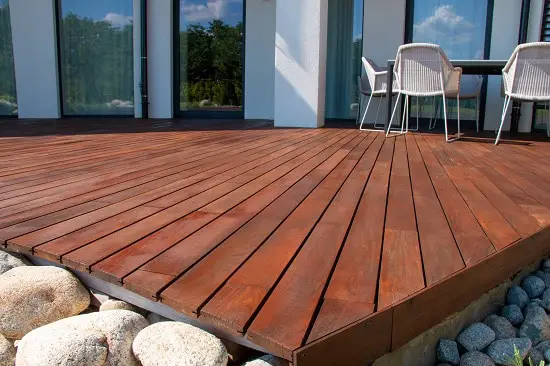
Corner Trim Is An Attractive Edging Choice
Corner trimming the edges of composite decking is like stair nosing, except the material is the same as the main decking boards. It’s not expensive, and because it matches the decking, it gives a very neat finish.
The disadvantage of using corner trim is that, like vinyl nosing, the raised edge can make cleaning the deck more problematic as it collects dust and water. It might be challenging to find matching corner trim, as some manufacturers do not produce it.
Fascia Boards Are A Favorite Edging Idea
Fascia boards provide the simplest and easiest way of edging your deck and are one of the neatest. The fascia board is attached perpendicular to the ends of the decking, covering them. It is then finished flush with the top of the deck.
The advantage of fascia board edging is that it is elegant, inexpensive, and quick to install. It provides a uniform, solid strip of edging and can be a contrasting color or an exact match with the decking board.
The one disadvantage of fascia board deck edging is that it’s thinner than the decking board and, being on the edge of the deck, will be subject to wear and tear. As a result, it may have to be replaced a few times during the deck’s life. It’s also possible for water to be trapped between the fascia board and the decking ends, leading to damage over time.
We have a Deck Edging Ideas Infographic here if you need a memory jogger or to share. Clicking the image will make it bigger and open in a new tab.
Picture Frame Or Racetrack Edging Idea
Picture framing your deck involves a lot of additional material and labor and needs to be carefully planned, but it will give it “the edge” over your neighbor’s deck.
It provides a striking, attractive border and effectively hides the decking board ends. The most straightforward picture framing consists of a single trim board running along the edge of the deck, but it can be made more elaborate by using two parallel trim boards, making the frame wider.
The trim can be matched to the decking boards, but it can also be stained a darker color in the case of natural wood or selected in a contrasting color if a composite. Additional joists and blocking are required to support the frame securely, so this is ideally a job for a professional.
The advantage of picture framing a deck, apart from the aesthetic appeal, is that it defines the edge very well and provides a safety factor for young children or older folk who may stumble and slip at the edge of the deck.
The frame also integrates perfectly with steps if your deck is raised. As it is made of the same material as the deck, the frame needs no additional maintenance.
The disadvantage, as mentioned, is the additional cost and time involved in designing, preplanning, and installing the picture frame deck edging to a high standard. If not done well, the picture frame can detract from, instead of adding to, the visual appeal of your deck.
if you are wondering if your deck needs a skirt you can check out the article below

Raised Seating And Plant Boxes As Edging
By building a bench around the perimeter of your deck, you combine seating, safety, and, designed correctly, a beautiful edging to your deck. The bench and deck are made from the same material, natural wood or composite, and can be open or boxed to provide storage space for cushions, garden tools, or barbecue equipment.
You can combine the seating with plant boxes to soften the edge and bring your garden up to deck level.
Advantages of built-in seating include the fact that it’s as maintenance-free as the deck itself. It’s practical, as you won’t need to provide outdoor furniture when entertaining. Combined with fascia boarding, it will protect the deck board ends very effectively. The bench will also provide the same safety function as a fence.
The disadvantage of built-in seating is just that- it’s built-in. Straight-line seating is not ideal when socializing. It can also look bulky on smaller decks unless kept open and relatively low.
A Rockery Can Make A Stunning Edge For Your Deck
If your deck is not raised, you can create a maintenance-free, very inexpensive border by bringing your garden right up to the edge of the deck by placing rocks up to deck height around the perimeter. You can soften the deck edging with plants, creating changing colors and textures with the seasons.
One advantage of a rockery edge is that it’s easy to set up and maintain. You can select rocks that blend in with the color of the deck or one that contrasts strongly both in color and texture with the wood look of the decking. Make sure you think about the gravel under your deck to make sure the color and texture ties in well.
The only problem with a planted rockery edge is that it requires occasional watering, which may affect the ends of wooden decking boards unless they are protected somehow. This can be achieved by inserting a low plastic roll-out barrier between the rockery and the edge of the deck.
Pebble Pathway As Deck Edging
At the edge of a ground-level deck or at the base of steps leading from a raised deck, pebbles filling a shallow, plastic-lined trench form a lovely deck edging with little effort and minimal cost.
You can keep it narrow if it’s not intended as a walkway or broaden it to make it a usable path. Further enhancement can be achieved by inserting lighting (solar or electrical) along the perimeter.
If you feel that loose pebbles may not be a suitable material for a path, a further option is to lay pavers at footstep-length intervals along the path and fill the empty spaces between pavers with pebbles. This will make it easier for younger and older to use the path, and it will look equally attractive.
Advantages of using pebbles include the fact that it’s so easy to install. It’s a free-form deck edging that can follow the exact shape of your deck, thus highlighting its design, and can be filled with pebbles of all colors to fit in with your overall theme.
Utilize Brick Edging For A Rustic Look
Building a brick edge to a ground-level deck can link it to the house’s architectural design. The brick is laid vertically on a concrete foundation so that its top edge is flush with the deck boarding, creating the effect of a low skirt.
Brick deck edging can add a rustic look to a wooden deck, is relatively easy to build, and requires no maintenance except for occasional cleaning. It can be combined with a pebble or paved pathway, or it can act as a barrier to prevent grass from growing up to and under the deck.
The only real disadvantage of this edging of this kind is that the brick is rough and hard and may hurt tender feet. If repeatedly stood on, it’s possible that the odd brick may be dislodged and need to be re-laid.
Using Plants And Shrubs For Edging A Deck
A soft, non-structural edge to a deck can be in the form of an evergreen hedge, which can be grown to the desired height for a raised deck or kept low to edge a ground-level deck. Alternatively, an attractive mix of flowering plants, shrubs, and grasses can be grown to form a natural divide between the deck and garden area.
This mixed deck edging can be at ground level or planted in raised planting boxes to create more height. The boxes can be made with the same material as the deck for an integrated look or constructed with brick as a solid contrast to the deck – it’s a personal choice.
The idea of using plants instead of artificial material for edging your deck will appeal to the keen gardener and the more environmentally aware. It offers a softer division between house and garden and is ever-changing, adding to its character.
As with all gardens, a planted edge will require regular feeding, trimming, and care. If you’re living in a harsh climate, this might not be a practical option, but if you live somewhere where plants thrive throughout the year, it could be the best idea of all.

Conclusion
The primary purpose of providing deck edging to the decking boards of your deck is to enhance its appearance and make it an even more valuable feature of your home. At the same time, the edging must prevent, or at least reduce, damage and deterioration from rain and dirt getting trapped in any part of the deck. Also, your edging must require no more maintenance than the deck itself.
Researching decking has brought into focus the benefits of composite decking materials compared to natural wood in terms of long-term maintenance costs and longevity.
Nevertheless, there are other factors to consider, so the deck edging ideas that we have highlighted apply in most cases to both materials, and the choice of which of them to go for depends entirely on you. Good luck!
References
- https://www.homesandgardens.com/gardens/deck-edging-ideas#
- https://dailyhomeideas.com/deck-edging-concepts-10-greatest-methods-to-edge-a-deck.html
- https://decksbye3.com/8-ways-to-finish-the-composite-decking-ends/
- https://www.decks.com/how-to/articles/how-to-install-a-picture-frame-deck-edge

